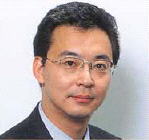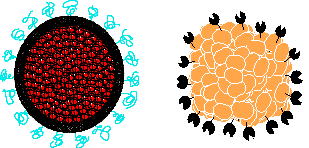(Macromolecular Chemistry)

(Macromolecular Chemistry)

(b. 1963), B.S. (1986, Waseda), M.Engr. (1988, Waseda), Ph.D. (1991, Waseda), Research Fellow of the Japan Society for the Promotion of Science (1990), Res.Assoc. (1991. Waseda), Assist. Prof. (1993. Waseda), Assoc. Prof. (1996. Waseda), Prof. (2005. Waseda), Editor of Artificial Blood.
keywords
Macromolecular Chemistry / Molecular Engineering / Molecular Assembly / Red Cell Substitutes / Electron-, Ion-Conductive Polymers
Room 65-208
3-4-1 Ohkubo, Shinjuku-ku, Tokyo 169-8555, Japan
Tel: +81-3-5286-3217
Fax: 81-3-5286-3217
E-mail:takeoka@waseda.jp
Research Interests
Research in our group is directed toward the assembling structures and cooperative phenomena of molecules such as amphiphiles (phospholipids, glycolipids, aminolipids), water-soluble polymers (polyelectrolytes, polysaccharides), proteins, and supramolecules in the aim of the functional nanodevices.

left: nanocapsule for artificial red blood cells
right: nanoparticle for artificial platelets
1DLarge-scale preparation of nanocapsules by controlling molecular assembly for artificial red blood cells.
Phospholipid bilayer vesicles (250nm) which encapsulate concentrated hemoglobin (Hb-vesicles) act as artificial red blood cells. We are succeeded in preparing the Hb-vesicles in large scale by precise control of molecular assembly, changing the temperature, pH, ionic strength, shear rates and inventing apparatus such as a serial multistep extruder and ligand-exchanger. The surface modification with nevatively-charged novel lipids and polyethyleneglycol lipids enables us long-term storage, good blood compatibility, and long blood circulation. Collaborating with several medical groups, animal tests as artificial red blood cells are going.
2DConstruction of nanoparticles with molecular recognition parts for artificial platelets
@We are succeeded in preparing nanoparticles of recombinant human serum
albumin by using the thiol-disulfide exchange reaction and molecular assembling
property. Receptor glycoproteins of platelet membrane responsible to subendothelium
recognition or synthetic oligopeptide relating to platelet aggregation
were conjugated to the nanoparticles. The particles recognize the bleedingsite
and accumulate with platelets, vWf, and fibrinogen in vitro and in vivo.
We are obtaining interesting results such as adhesion and rolling by comparing
this system with the phospholipid vesicle system and also developing these
systems towards the effective novel drug delivery systems.
3DConstruction of energy-storage and conversion systems using supramolecular assembly.
We are constructing supramolecular assemblies of porphyrin and calixarene derivatives with hydrogen-bonding. Redox-active electron conducting polymers, heat-resistant proton-conducting polymers are synthesized and studied for energy-storage and converstion systems.
Representative Publications
1)Hemostatic effects of polymerized albumin particles bearing rGPIa/IIa in thrombocytopenic mice, Biochem. Biophys.Res.Commun., 306, 256-260 (2003).
2)Function of fibrinogen -chain dodecapeptide-conjugated latex beads under flow, Biochem.Biophy. Res.Commun., 312, 773-779 (2003).
3)Effective encapsulation of proteins into size-controlled phospholipid vesicles using freeze-thawing and extrusion, Biotechnol.Prog., 19,1547-52(2003).
4)A Duplex of tetra(2-pyridyl)porphyrin and tetra hydroxylcalix[4]arene, Chem.Lett., 32, 1052-1053 (2003).
5)Rolling properties of rGPIb -conjugated phospholipid vesicles with different membrane flexibilities on vWf surface under flow conditions. Biochem.Biophys.Res. Commun., 296,765-770 (2002).
6)Effect of Hb-encapsulation with vesicles on H2O2 reaction and lipid peroxidation. Bioconjugate Chem., 13, 1302-1308 (2002).
7)Systemic and microvascular responses to hemorrhagic shock and resuscitation with Hb vesicles. Am.J.Phys.-Heart Circulatory Physiol., 283, H1191-1199 (2002).
8)Hemoglobin-vesicles as oxygen carriers - Influence on phagocytic activity and histopathological changes in reticuloendothelial system, Am.J.Pathol., 159, 1079-1088 (2001).
9)Synthesis of disulfide-containing aniline and copolymerization with aniline, Macromolecules, 6, 2751-2756 (2001).
10)Conjugation of von Willebrand factor-binding domain of platelet glycoprotein IB alpha to size-controlled albumin microspheres, Biomacromol., 1, 290-295 (2000).
11)Synthesis and assembly of poly(ethylene glycol)-lipids with mono-, di-, and tetraacyl chains and a poly(ethylene glycol) chain of various molecular weights, J.Am.Chem. Soc., 122, 7927-7935 (2000).
Back to: